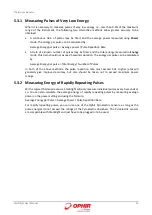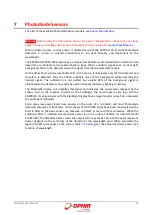
StarBright User Manual
39
7
Photodiode Sensors
For a list of the available Photodiode Sensor models, see
Warning:
Before using the Photodiode sensor for power measurement, check that your laser
power, energy, and energy density do not exceed the sensor ratings. See
When a photon source, such as a laser, is directed at one of the PD300 or 3A-IS series Photodiode
detectors a current is created proportional to the light intensity and dependent on the
wavelength.
The PD300 and PD300-3W sensors have a unique dual detector sensor (patented) in which the two
detectors are identical and connected back to back. When a uniform signal, such as room light
background, falls on the detector sensor the signal from the two detectors cancels.
On the other hand, when a laser beam falls on the sensor, it illuminates only the first detector and
therefore is detected. Thus the PD300 subtracts most of the background while detecting the
desired signal. The subtraction is not perfect but usually 98% of the background signal is
eliminated so the detector can usually be used in ordinary laboratory lighting conditions.
The StarBright display unit amplifies this signal and indicates the power level received by the
sensor. Due to the superior circuitry of the StarBright, the noise level is very low, and the
PD300/3A-IS series sensors with the StarBright display have a large dynamic range from nanowatts
to hundreds of milliwatts.
Since many low power lasers have powers on the order of 5 to 30mW, and most Photodiode
detectors saturate at about 2mw, most sensors of the PD300 series have been constructed with a
built in filter so the basic sensor can measure to
30mW or more without saturation. When the
additional filter is installed, the maximum power is on the order of 300mW (or 3W with model
PD300-3W). The PD300 saturates when the output current exceeds 1.3mA so the exact maximum
power depends on the sensitivity of the detector at the wavelength used. When saturated, the
legend "OVER" will appear on the screen.
gives the actual maximum power as a
function of wavelength.















































